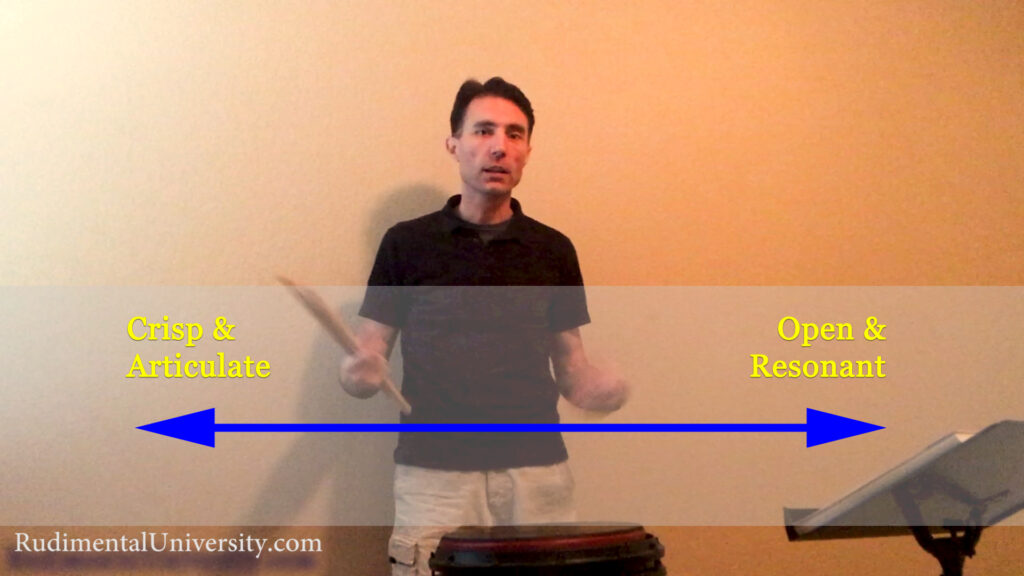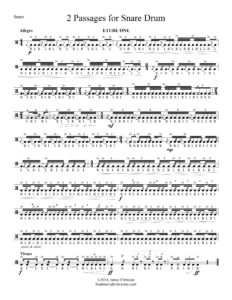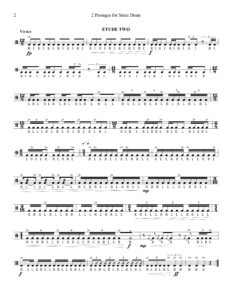
Resonance is a big buzzword in percussion today. Unfortunately, it is often discussed as if there is only one proper style and technique to achieve it. In the process, a great deal of music is ignored. Today I want to dismantle it a bit and show that there is a full spectrum of resonance. On one end, you have crisp, articulate playing. On the other end, you have open, resonant playing. Both approaches are necessary for different musical situations. This video showcases two snare drum etudes played with different approaches to demonstrate the variety of techniques.
You can download the etudes for your own enjoyment below. A transcript of the video follows.


TRANSCRIPT
Introduction: The Resonance Spectrum
Hello, everybody. James Christian here from RudimentalUniversity.com.
Today, I want to talk about the resonance spectrum. A lot of people have a very controlled technique where they’re tight and articulate in everything they play. And then some people have a very resonant technique where it’s very loose and open.
A lot of Internet arguments on different drumming styles center around these two different technique approaches. Today I want to talk about how they’re actually on a spectrum. And you need to know the entire spectrum.
Two Snare Drum Etudes
For today’s video, I’m going to play two etudes. One is faster and tighter and requires more of a controlled technique. And the second etude is a more open style–or the writing is more open and lends itself more to an open style.
And I want you to observe the difference in the techniques employed for both. I think you’ll find there is room for both, and you need both in different situations.
So I’ll start with the tighter, more controlled etude. And I will follow it up with the more open, more rebound-oriented etude.
[Etude 1 performed] [Etude 2 performed]If you’d like to download the music to those etudes to learn them yourself or to simply follow along on the video, the link will be included below. And you can download them at RudimentalUniversity.com.
Differences in Style & Approach
I do want you to notice in watching the videos–I think in the first video, if you tried to play that with a really legato/rebound-style technique, it just wouldn’t work. You wouldn’t be able to get the fast controlled notes on the flams and the softer dynamics and all of that.
Conversely, on the second etude, if you tried to play that really tightly, I feel like you would lose a lot of the expression you would get from taking a more open approach and style.
So I feel like both performances were good. I’m biased, of course, because I performed them. But I feel like both of them are good, but they’re different in the style and approach to them. And it is a full spectrum that you need to understand.
Avoiding the Extremes
So if you get really tight and rigid, it gets just… stiff sounding. And you almost get buzz notes if you just get super stiff with your stick. But then if you get super loose and relaxed, you lose all control, and the stick is almost about to fall out of your hand.
So you need to be able to control the full spectrum of resonance–really resonant to really crisp and tight and controlled. And you need to be able to explore the full range without going past a good sound on either end.
Conclusion
So that’s all I want to say on that today. I have more thoughts on this that I’ll probably save for a future video. But hopefully that gives you some food for thought, and it helps you think about how you’re approaching different passages of music.
I hope you enjoyed that. Please like, share, subscribe, comment. Let me know your thoughts on this, and that would help me out a lot.
I hope you enjoyed this video, and I will catch you next time. Thanks for watching. Bye!
